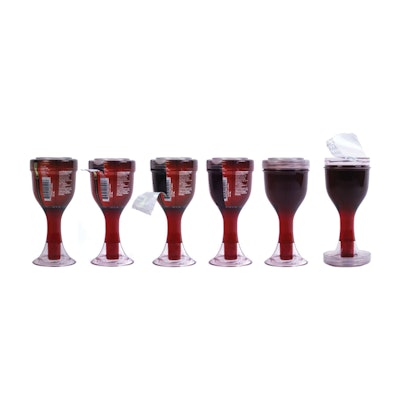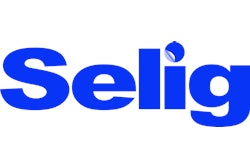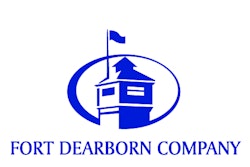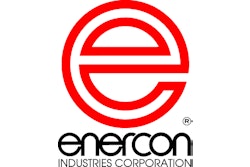Zipz Inc., New Brunswick, NJ, has successfully launched its PET-packed, single-serve wines into a range of new retail and foodservice markets. The widely publicized wine packaging concept, designed in collaboration with SnS Design, Inc., is unique and elegantly stylish. But it took some ingenuity, determination, and teamwork to make the packaging happen with consistent efficiency, seal integrity, and shelf-life protection assurance.
It helped that Zipz had a powerful partner as it developed its innovative package: Fetzer Vineyards of Hopland, CA. That’s where a custom-designed proprietary packaging line fills, seals, labels, and case packs the single-serve wines. A Zipz licensee, Fetzer sells its Fetzer Crimson and Fetzer Quartz brands in the PET glass.
The wine glasses are injection molded of PET by Envino. Sidewall thickness may vary slightly but is up to 0.110 inch. Each container weighs 83 g.
The original design incorporated a hot-iron conduction seal of a foil-based membrane to the rim of the container. The problem with conduction sealing was that there were too many leakers. The headspace in each container is backflushed with nitrogen gas to drive out ambient air that could have a negative effect on wine quality and shelf life. This backflushed nitrogen causes a certain amount of internal pressure to build up in the headspace, and the conduction seal was just not able to hold.
J. Henry Scott, Founder and CEO of Zipz Inc., notes, “Conduction sealing and PET were not a good mix. Induction sealing is a superior technology. It produces more consistent seals and fewer failures.”
Scott enlisted the consulting services of Bruce Cleevely, retired Vice President of Product Development for Berry Plastics and holder of several closure patents, to conquer the shortcomings of the original container. It wasn’t just wine leakage from the container lip that needed to be addressed. Also problematic was oxygen migration through the PET container body.
Cleevely addressed the seal integrity issue by working with Selig. Together they determined that the Selig Lift n’ Peel™ foil/polyester film induction cap seal liner was the best option for this product and packaging application. The system provides hermetic seals to inhibit leaking and oxidation, and the lidding membranes are easy to apply and peel off.
Two other significant adjustments were made. First, Envino switched to a different mix of PET that incorporates oxygen-scavenging minerals. Second, the injection molding tooling was modified so that threads became part of the container finish. Threads were added to the injection molded polypropylene closure, too. On top of the much better membrane seal integrity that comes with induction sealing, the threaded closure brings additional sealing pressure into the mix.
The line at Fetzer
As currently configured, the filling line at Fetzer begins with operators emptying the plastic containers from corrugated reshippers onto a conveyor that takes them to a rinser from McBrady Engineering and then to a Trepko rotary filler. Filling is done at a speed of 50/min and is followed by nitrogen dosing, cap application, and cap torqueing, all done by the Trepko system. The 70-mm injection-molded closure is torqued down with approximately 30 inch pounds of pressure.
Induction sealing of the Lift ‘n Peel barrier seal membrane is next, and it’s done on a Super Seal Touch 700 system from Enercon. This equipment came highly recommended, as consultant Cleevely had many years of familiarity with Enercon equipment and technologies. The Super Seal Touch system features touch-screen interface, internal monitoring, recipe management, password security, descriptive fault information, and trouble-shooting support. A fully integrated inspection system detects stalled containers, missing foil membranes, and cocked caps.
Mounted over a conveyor, the induction sealing system performs a non-contact heating process that welds a foil laminate inner seal to the lip of the glass. The standard induction sealing system incorporates two components—the power supply and the sealing head. The power supply is an electrical generator operating at medium to high frequencies. The sealing head uses an inductive coil. When energized by the power supply, the sealing head produces an electromagnetic current that heats the foil laminate membrane sealing material. The heat, combined with the pressure produced by the closure, bonds the seal to the lip of the container, creating a hermetic seal. (See demonstration videos at pwgo.to/992 and at pwgo.to/993).
After the containers are filled and induction sealed, a feed screw from Apacks inverts and spaces the containers so they are in a position to receive the shrink sleeve, which is applied by an applicator from PDC International (www.pdc-corp.com). The PETG labels are gravure-printed in four or five colors and are from Fort Dearborn (www.fortdearborn.com). A shrink tunnel, also supplied by PDC International, shrinks the PETG labels tightly to the container contours. The shrink-sleeve label covers the closure and the container, creating an excellent tamper-evident feature. In addition to enhanced tamper-evidence, shrink sleeving around the filled and sealed containers serves two other important purposes—it provides UV light barrier and keeps the packaging clean and uncontaminated during shipping and handling.
Estimated shelf life for the Zipz 187-mL (approx. 6.3 fl. oz.) wines is approximately two years. To open the container, the consumer tears (or “unZipz”) the perforated shrink label strip, twists off the cap closure, and peels open the foil/film membrane lip seal. After removal by consumers, the closures can be used as coasters and then re-applied to help prevent spills.
A good partner
J. Henry Scott says, “Enercon has been a very good packaging partner and has been very helpful in the installation and integration process. I would recommend them to anyone looking for induction sealing equipment.”
He adds, “We haven’t had a leak since installing the Enercon induction sealer. The reliably consistent performance of the sealer, combined with the new oxygen-scavenger-imbued PET containers, and threaded 70mm closures, give us a wine shelf life approaching two years.”
Zipz wines now are served at a dozen major baseball league ballparks, at least 10 football stadiums, and hundreds of other venues—such as zoos, amusement parks, and convention centers. Typical retail prices are in the range of $2.99 to $3.50. Any public setting where glass containers can be a potential hazard offer a marketing opportunity for these single-serve PET wine glasses. Zipz currently is testing its recyclable, BPA-free, high-quality stemware with several of the world’s largest wineries. And the company’s next project is single-serve mixed drinks.
One other modification that might surface in the future has to do with the container’s 83-g weight. Investigations now underway are aimed at shaving a few grams off.
See video of how Zipz developed at pwgo.to/991
To see a spin + zoom 360° photo, click here.

































